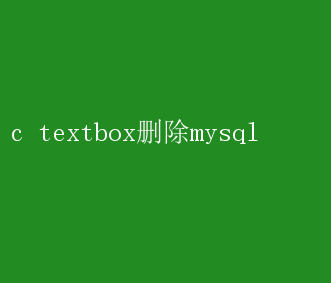c textbox删除mysql简介:

如何高效地在MySQL中删除与C Textbox相关的数据 在现代应用程序开发中,数据库操作是不可或缺的一部分
MySQL作为一种广泛使用的关系型数据库管理系统(RDBMS),提供了丰富的功能来存储、检索、更新和删除数据
在用户界面(UI)层面,文本框(Textbox)是一种常见的输入控件,用于接收用户输入
本文将深入探讨如何通过C语言程序中的文本框输入来删除MySQL数据库中的数据,并介绍一种高效且安全的方法来实现这一目标
一、准备工作 在开始之前,确保你已经安装了MySQL数据库,并具备基本的C编程和MySQL操作知识
此外,你还需要安装MySQL的C语言开发库(如MySQL Connector/C)
1.安装MySQL数据库:你可以从MySQL官方网站下载并安装适用于你操作系统的MySQL版本
2.安装MySQL Connector/C:这是MySQL官方提供的C语言开发库,允许你从C程序中与MySQL数据库进行交互
二、设置MySQL数据库 假设我们有一个名为`testdb`的数据库,其中包含一个名为`users`的表,表结构如下: sql CREATE TABLE users( id INT AUTO_INCREMENT PRIMARY KEY, username VARCHAR(50) NOT NULL, email VARCHAR(100) NOT NULL ); 我们需要在`users`表中插入一些测试数据: sql INSERT INTO users(username, email) VALUES (alice, alice@example.com), (bob, bob@example.com), (charlie, charlie@example.com); 三、C语言与MySQL交互 在C语言中,通过MySQL Connector/C库与MySQL数据库进行交互
以下是一个简单的步骤指南,展示如何从文本框获取输入并删除MySQL中的数据
1.包含必要的头文件: c include include include include 2.连接到MySQL数据库: c MYSQLconn; MYSQL_RESres; MYSQL_ROW row; conn = mysql_init(NULL); if(conn == NULL){ fprintf(stderr, mysql_init() failedn); exit(1); } if(mysql_real_connect(conn, host, user, password, testdb,0, NULL,0) == NULL){ fprintf(stderr, mysql_real_connect() failedn); mysql_close(conn); exit(1); } 3.从文本框获取输入: 在实际应用中,你可能需要从图形用户界面(GUI)的文本框中获取用户输入
这里为了简化,我们使用标准输入来模拟文本框输入
c char input【50】; printf(Enter the username to delete:); scanf(%s, input); 4.构建并执行删除SQL语句: c char query【256】; sprintf(query, DELETE FROM users WHERE username=%s, input); if(mysql_query(conn, query)){ fprintf(stderr, DELETE failed. Error: %sn, mysql_error(conn)); mysql_close(conn); exit(1); } else{ printf(User deleted successfully.n); } 5.关闭连接: c mysql_close(conn); 四、完整示例代码 以下是一个完整的C程序示例,该程序连接到MySQL数据库,从用户输入获取要删除的用户名,并执行删除操作
c include include include include int main(){ MYSQLconn; MYSQL_RESres; MYSQL_ROW row; char input【50】; char query【256】; // Initialize the MySQL connection conn = mysql_init(NULL); if(conn == NULL){ fprintf(stderr, mysql_init() failedn); exit(1); } // Connect to the database if(mysql_real_connect(conn, localhost, your_username, your_password, testdb,0, NULL,0) == NULL){ fprintf(stderr, mysql_real_connect() failedn); mysql_close(conn); exit(1); } // Get user input(simulate from a textbox) printf(Enter the username to delete:); scanf(%s, input); // Prepare and execute the DELETE statement sprintf(query, DELETE FROM users WHERE username=%s, input); if(mysql_query(conn, query)){ fprintf(stderr, DELETE failed. Error: %sn, mysql_error(conn)); mysql_close(conn); exit(1); } else{ printf(User deleted successfully.n); } // Close the connection mysql_close(conn); return0; } 五、安全注意事项 在实际开发中,直接从用户输入构建SQL语句是非常危险的,因为它容易受到SQL注入攻击
SQL注入攻击允许攻击者通过修改输入来操纵SQL语句,执行未授权的数据库操作
为了防范SQL注入,建议使用预处理语句(prepared statements)
预处理语句不仅可以提高性能(通过预编译SQL语句),还可以有效防止SQL注入
以下是使用预处理语句的示例代码: c include include include include int main(){ MYSQLconn; MYSQL_STMTstmt; MYSQL_BIND bind【1】; char input【50】; unsigned long length【1】; my_bool is_null【1】; int status; conn = mysql_init(NULL); if(conn == NULL){ fprintf(stderr, mysql_init() failedn); exit(1); } if(mysql_real_connect(conn, localhost, your_username, your_password, testdb,0, NULL,0) == NULL){ fprintf(stderr, mysql_real_connect() failedn); mysql_close(conn); exit(1); } printf(Enter the username to delete:); scanf(%s, input); stmt = mysql_stmt_init(conn); if(stmt == NULL){ fprintf(stderr, mysql_stmt_init() failedn); mysql_close(conn)
